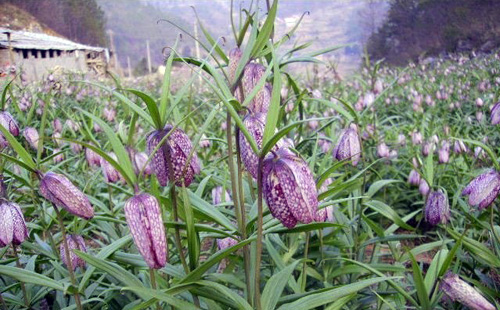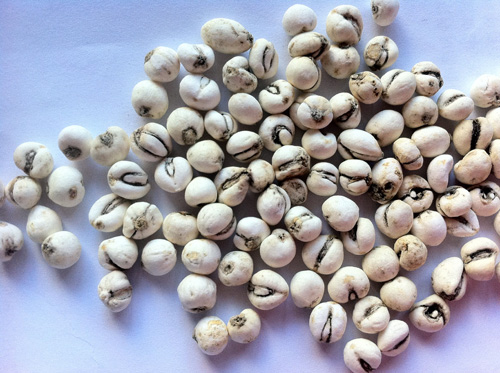Beimu (Bulbus Fritillariae) is divided into two kinds: Chuanbeimu (Bulbus Fritillarae Cirrhosae) and Zhebeimu (Bulbus Fritillariae Thunbergii) .
1. Chuanbeimu (Bulbus Fritillariae Cirrhosae) is the bulb of Fritillaria cirrhosa D. Don, F. unibracteata Hsiao et K. C. Hsia and F. Przewalskii Maxim., family Liliaceae. It is mainly produced in the areas of Sichuan, Yunnan, Gansu, Tibet of China, etc., dug and collected in summer and dried in the sun.
2. Zhebeimu (Bulbus Fritillariae Thunbergii) is the bulb of the same genus, Fritillaria Thunbergii, mainly produced in Xiangshan and Jinxian counties of Zhejiang Province, and cultivated artificially. The bulb is dug after the plant, withered and dried in the sun after it is cleaned. The crude one is used.
Medicinal Properties: Chuanbeimu (Bulbus Fritillariae Cirrhosae) is bitter and sweet in flavor, slightly cold in nature; Zhebeimu (Bulbus Fritillariae Thunbergii) is bitter in flavor and cold in nature. They are attributive to the lung and heart meridians.
Actions: Resolve phlegm and arrest cough, clear away heat and disperse stagnation.

Application
1. It is used for chronic cough due to lung deficiency with less sputum and dry throat, and cough due to exogenous wind and heat or cough due to stagnation of phlegm-heat with yellowish and thick sputum. Chuanbeimu (Bulbus Fritillarae Cirrhosae) and Zhebeimu ( Bulbus Fritillariae Thunbergii ) can all clear away lung-heat, resolve phlegm to treat cough due to phlegm-heat. They are usually combined with Zhimu (Rhizoma Anemarrhenae), such as Ermu San (Powder). Whereas, Chuanbeimu (Bulbus Fritillarae Cirrhosae ) is companied with the action of moistening the lung, so it is usually used for chronic cough due to lung deficiency with less sputum and dry throat and can be combined with Shashen (Radix Glehniae ) , Maimendong ( Radix Ophiopogonis ), Tianmendong (Radix Asparagi) and others that can nourish yin and moisten the lung; the action of Zhebeimu (Bulbus Fritillariae Thunbergii) to clear away fire and disperse stagnation is stronger, so it is usually used for exogenous wind and heat or cough due to stagnation of phlegm-heat and combined with Sangye ( Folium Mori ), Niubangzi ( Fructus Arctii ), Qianhu (Radix Peucedani ), Xingren ( Semen Pruni Armeniacae) and others that can disperse the lung to eliminate phlegm.

2. It is used for scrofula, carbuncle, mammary abscess and pulmonary abscess. Chuanbeimu (Bulbus Fritillarae Cirrhosae ) and Zhebeimu ( Bulbus Fritillariae Thunbergii) both have the actions of clearing away heat and disperse stagnation but Zhebeimu (Bulbus Fritillariae Thunbergii) is more effective in treating scrofula, it is usually combined with Xuanshen (Radix Scrophulariae) and Muli (Concha Ostreae), that is Xiaoluo Wan (Pill); For carbuncle and mammary abscess, it is usually combined with Pugongying (Herba Taraxaci), Tianhuafen ( Radix Trichosanthis ), and Lianqiao ( Fructus Forsythiae), etc. ; for pulmonary abscess, combined with Yuxingcao (Herba Houttuyniae), Xianlugen (Rhizoma Phragmitis, fresh), and Yiyiren (Semen Coicis), etc..
Usage and Dosage:
3 - 10 g is used in decoction for oral use and 1 - 2 g is used in the powder.
Notes:
It is incompatible with Wutou (Rhizoma Aconiti).







